Installation view of Patterns of Knowing
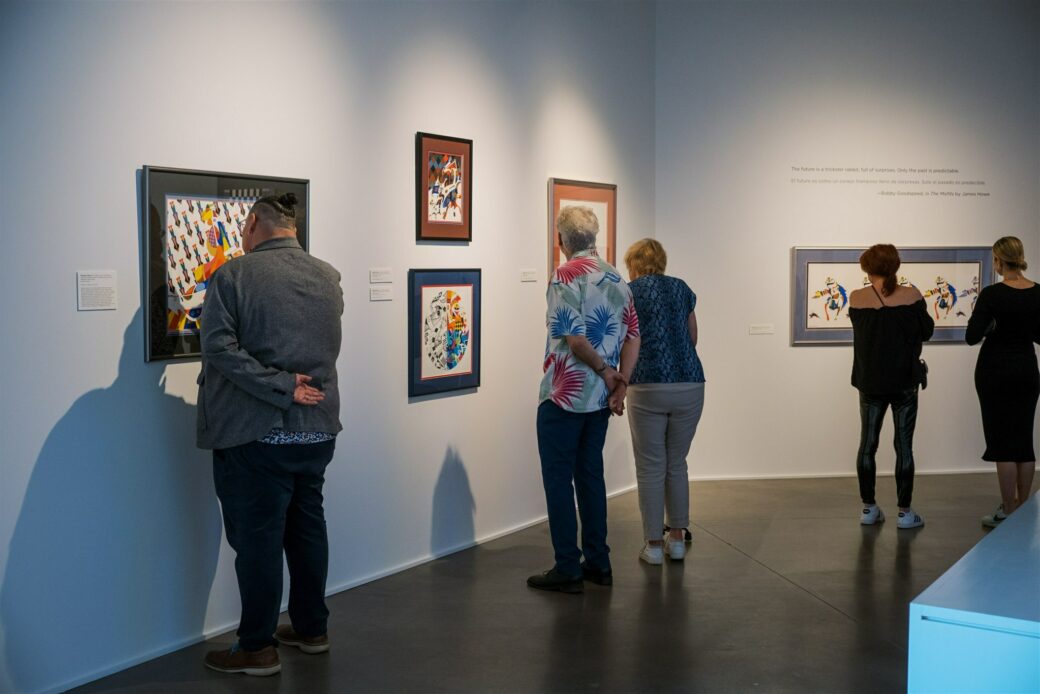

Installation view of Patterns of Knowing

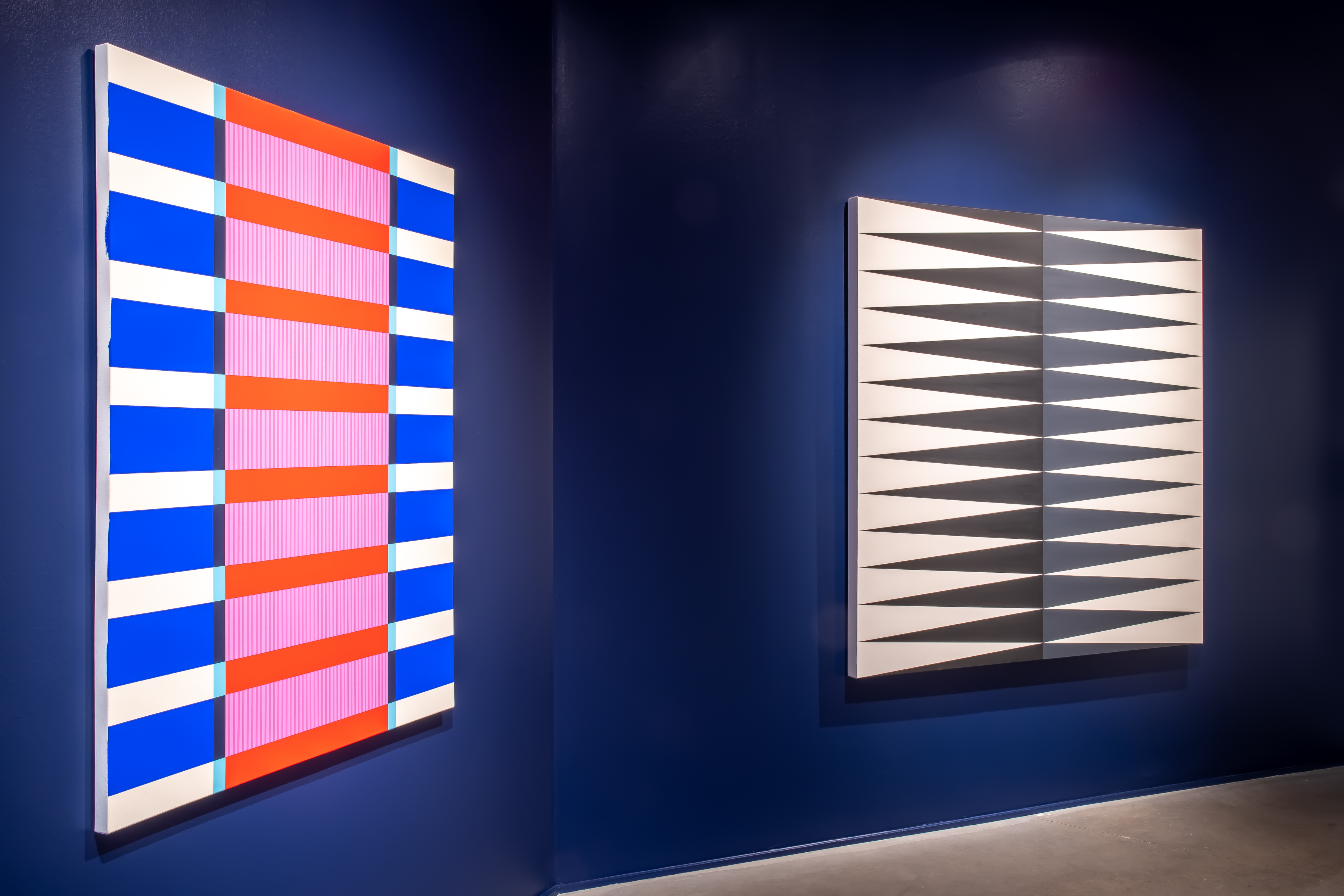
Jordan Ann Craig's Untitled (2019) and Sharp Tongue II (2022)
Just as the artists and their works on view utilize the past to inform the present, we’re taking a step back to examine, appreciate and honor the last five months Patterns of Knowing has spent in the Oklahoma Gallery.
Through the nearly 20 pieces of art from Jeri Redcorn (Caddo Nation of Oklahoma/Citizen Potawatomi), Jordan Ann Craig (Northern Cheyenne Tribe) and Benjamin Harjo Jr. (Absentee Shawnee Tribe of Oklahoma/Seminole), including ceramics, paintings, drawings and prints, a dialogue of the ever-evolving, living culture of Indigenous art-making practices has bloomed into not only an example of fruition, but as a sacred memorial for those before, those recently departed and those continuing onward.
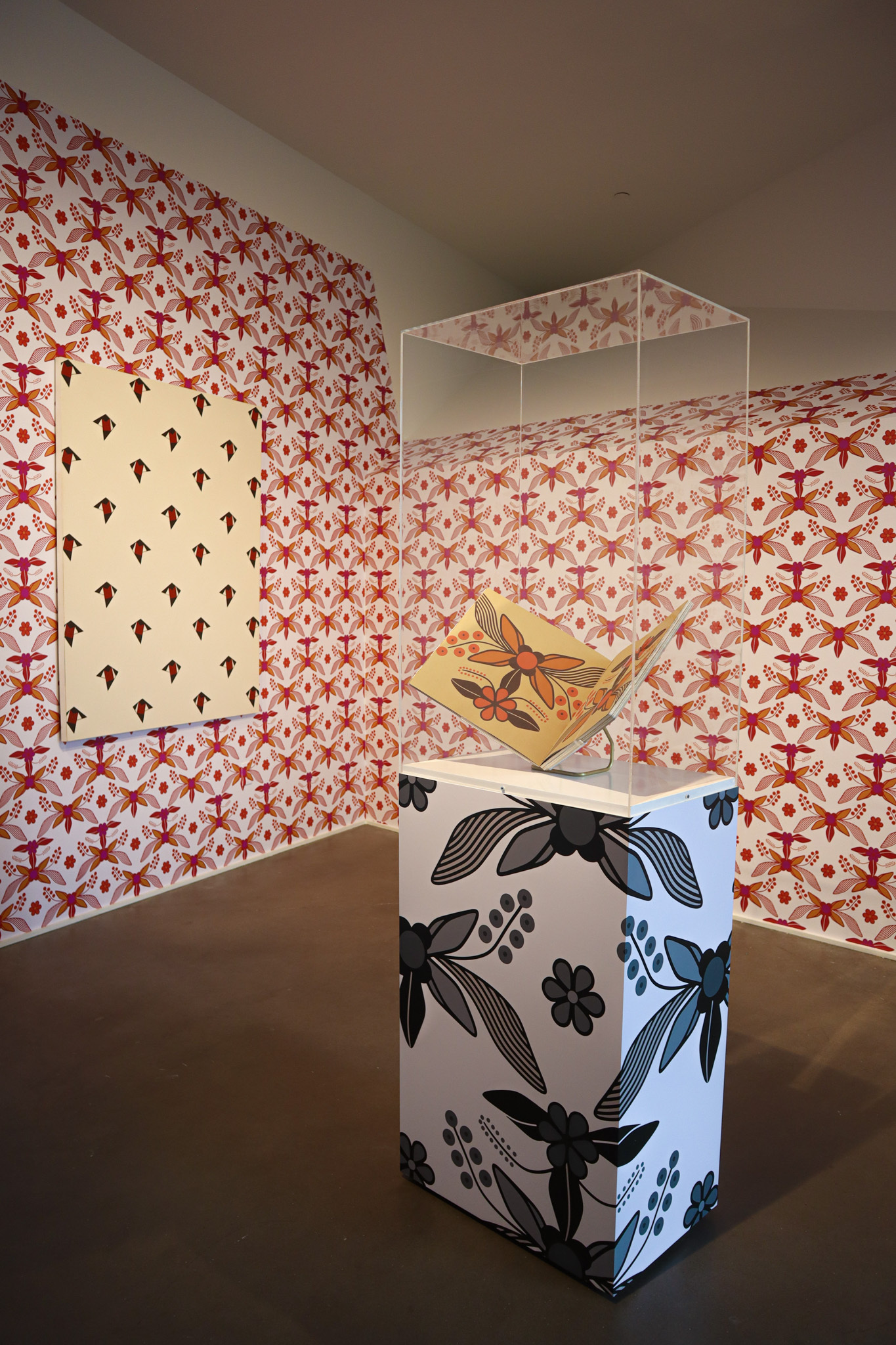
Installation view of Jordan Ann Craig's works
"Patterns of Knowing considers how Indigenous patterns embody intergenerational ideas, providing tangible links to ancestral thought," Associate Curator Pablo Barrera says. "By anchoring their inventive compositions to the heritage of their respective communities, [the artists'] artworks simultaneously preserve Indigenous visual language while adding to its evolution as a contemporary art form. ... [The exhibition] invites viewers to learn more about the lineage of artistic practices tapped by Craig, Harjo and Redcorn, and the ways that contemporary Native art engages Indigenous patterns and artistic principles."
This idea is represented in Craig’s Wallpaper I, Ladybugs Are Birds and Wallpaper II: Eat Flowers for Powers. Nestled in a pocket of the gallery, the corner is a vibrant wash of color and shapes, drawing visitors to Craig’s 48-page screen-printed book. Wallpaper I recontextualizes seven influential Indigenous ceramics patterns, inspired by an Acoma Pueblo parrot pot, which itself incorporated a flower motif from Pennsylvania Dutch textiles. Craig took these patterns designed for a 3-D surface and transposed them into 2-D during her artist residency in Amsterdam. In doing so, the book acts as a response to how Indigenous masterworks are often left out and misrepresented in contemporary craft manuals; Craig has begun to fill those gaps in Western art history.
“It has been an absolute honor to show work alongside incredible artists Benjamin Harjo Jr. and Jeri Redcorn,” Craig says. “I enjoyed every minute, from the brainstorming of the show to the opening reception, and seeing this amazing exhibition come together in a beautiful place with beautiful people.”
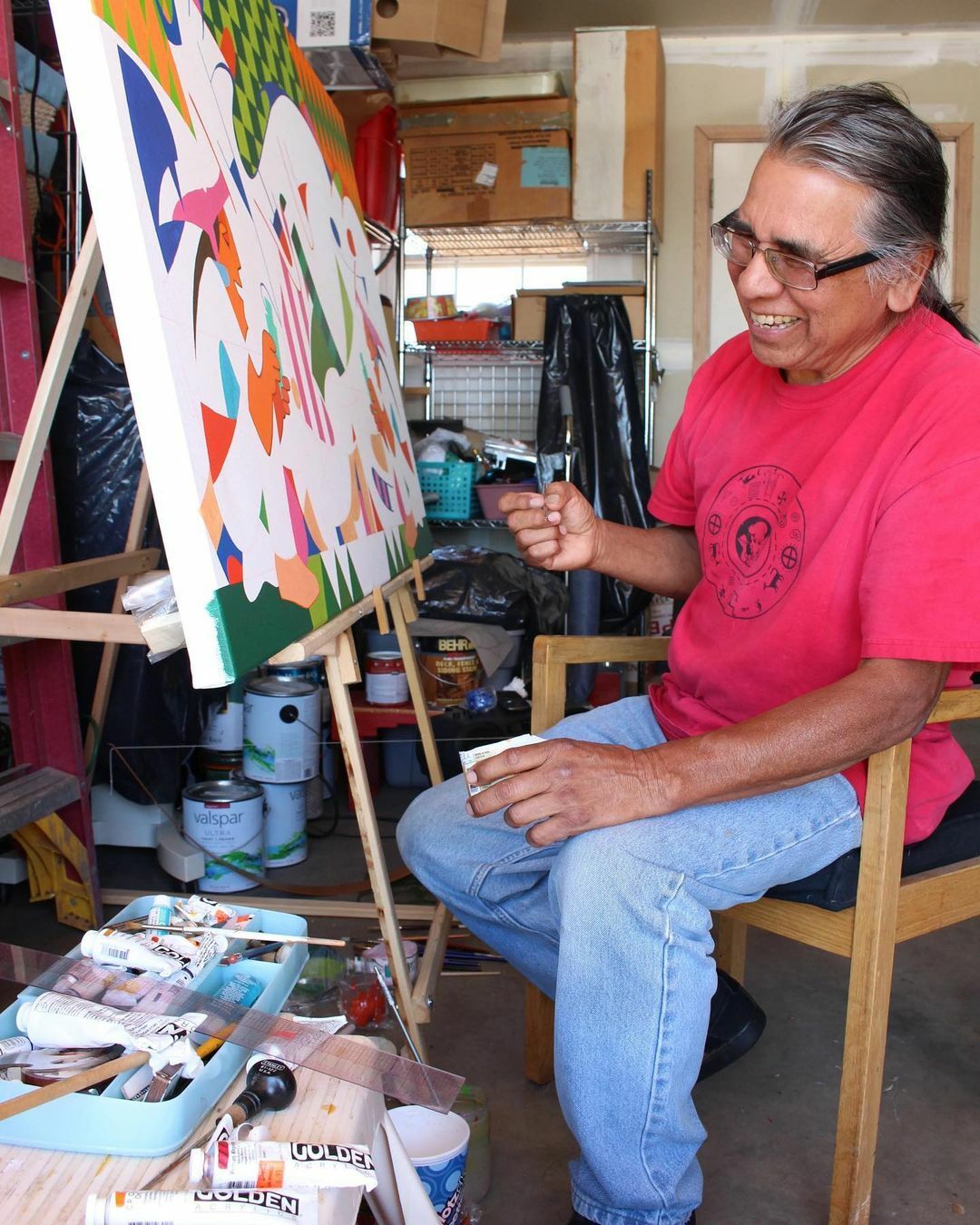
Benjamin Harjo Jr.
Three days after the opening of Patterns of Knowing, exhibiting artist Benjamin Harjo Jr. — endearingly Ben to most — passed on. And while knowledge of Harjo’s deteriorating health had been spoken of, had been prepared for, a time that felt like one of celebration and relief for a freshly opened exhibition suddenly became heavy with a palpable sense of finality. A pillar in the Shawnee, Seminole and larger Indigenous community, as well as a leader in the Oklahoma arts, Harjo’s departure was felt by many. From former students and tribe members to practicing artists, the mourning of an earnest soul — to the land, to his people, to all around him — was, and still is, one of a deep communal love.
"Benjamin Harjo Jr., painter, printmaker, draftsperson, and U.S. veteran, has left behind a legacy of work that will continue to have an impact on the Indigenous artistic landscape within Oklahoma," Barrera says. "The Patterns of Knowing exhibition became Benjamin Harjo Jr.’s last exhibition before he passed on. The experience of working with Benjamin shaped the exhibition’s purpose."
"The exhibition aimed to emphasize how each artists’ process is in step with intergenerational elaboration, experimentation and innovation of Indigenous visual language. Their works tasked the viewer to venture beyond associations to the source culture and move toward an understanding of the knowledge these patterns communicate. The artists do not treat them as symbols, but rather as semiotics to engage with the essential aspects of an intellectual history. For Benjamin, treating these patterns as part of a language that connects him to his culture enabled him to illustrate their constantly evolving present experience."
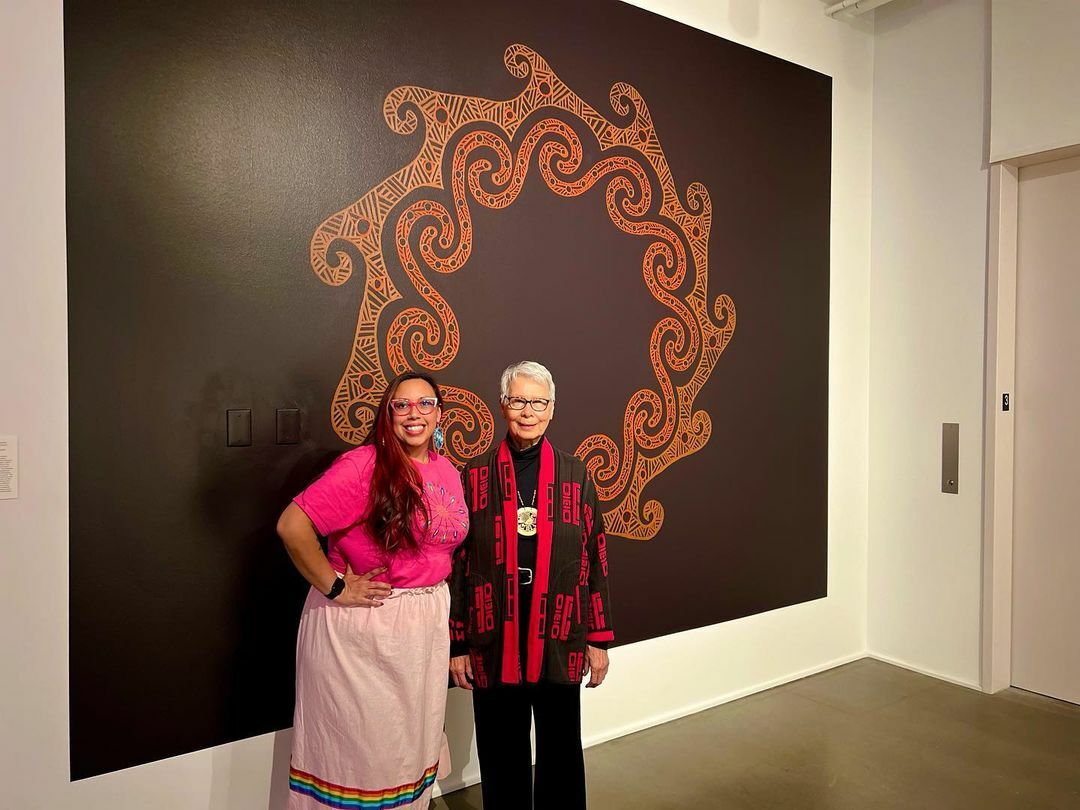
Artists Kristin Gentry (left) and Jeri Redcorn (right)
Local Indigenous artist Kristin Gentry (Choctaw Nation), mentored by Harjo, was contacted by Barrera for a potential collaboration with Redcorn for the exhibition. Redcorn’s works on view include her traditional Caddo pottery, as well as a new mural, Ayo Wahdut Kuku Bit (Sky Earth Water II), a version of the original iteration at First Americans Museum. Gentry, who had known Redcorn due to a prior connection through FAM, was asked to fabricate Redcorn’s vision. The answer was a resounding yes.
“When [Barrera] chatted with me about the possibility of painting Jeri's mural as a living fabricator, I said yes immediately!” Gentry says. “Although I am not Caddo, Jeri knew my work and agreed with Pablo for me to do the mural. I wanted to keep her as the focus as much as possible, and I thought that I wanted to try to use firing debris or clay pigments to mix into the paint. Jeri followed up confirming the idea was good, and she gave me a hand digging clay from both Oklahoma and Texas where the Caddo Nation spans today.”
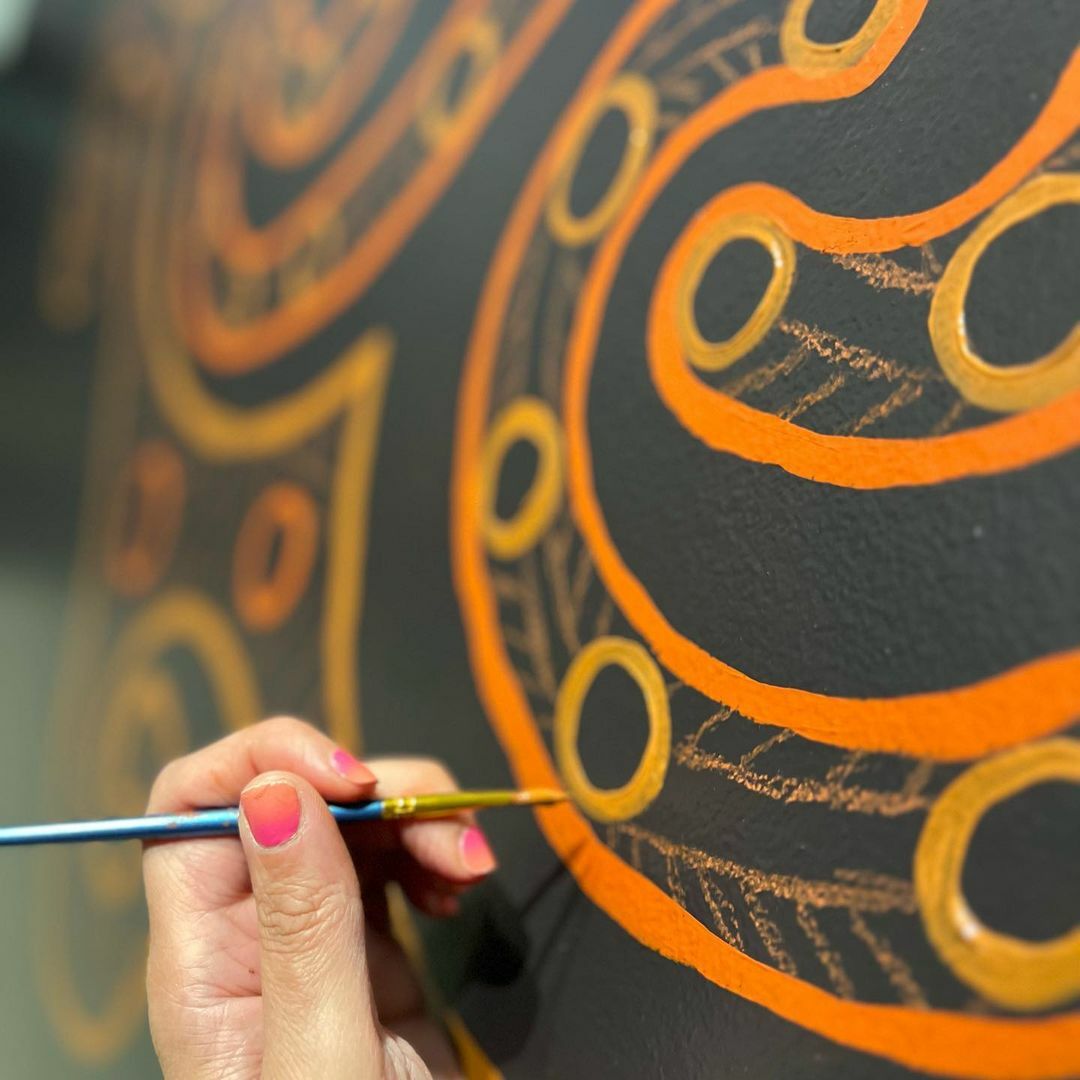
In-progress view of Gentry painting
Working with Porch Art Supply, Gentry was able to create a warm, subtly textured pigment for the mural, crushing and mixing the medium by hand. The Indigenous artist then took to the wall, tracing Redcorn’s design, and finished the mural with the newly made paint. The process was recorded through a time-lapse video. While contributing to the mural was an honor for Gentry, news of Harjo became more frequent.
“Unfortunately, during this painting time, Ben's health really declined,” Gentry explains. “I'd been communicating with Ben and his wife Barbara while I painted Jeri's mural, since Ben was another artist curated into the show with her. It was a really special experience to be creating for a show with him. I was able to call him during all of that and have what I knew, but didn't want to admit, were our last phone conversations.”
At the beginning of the exhibition’s artist talk featuring Redcorn and Craig, moderated by Barrera, Gentry read out a statement Harjo had written for the evening, a final word on his final exhibition. Prior to the talk, a smudging ceremony was held with Indigenous community members as a tribute to Harjo through smoke and song.
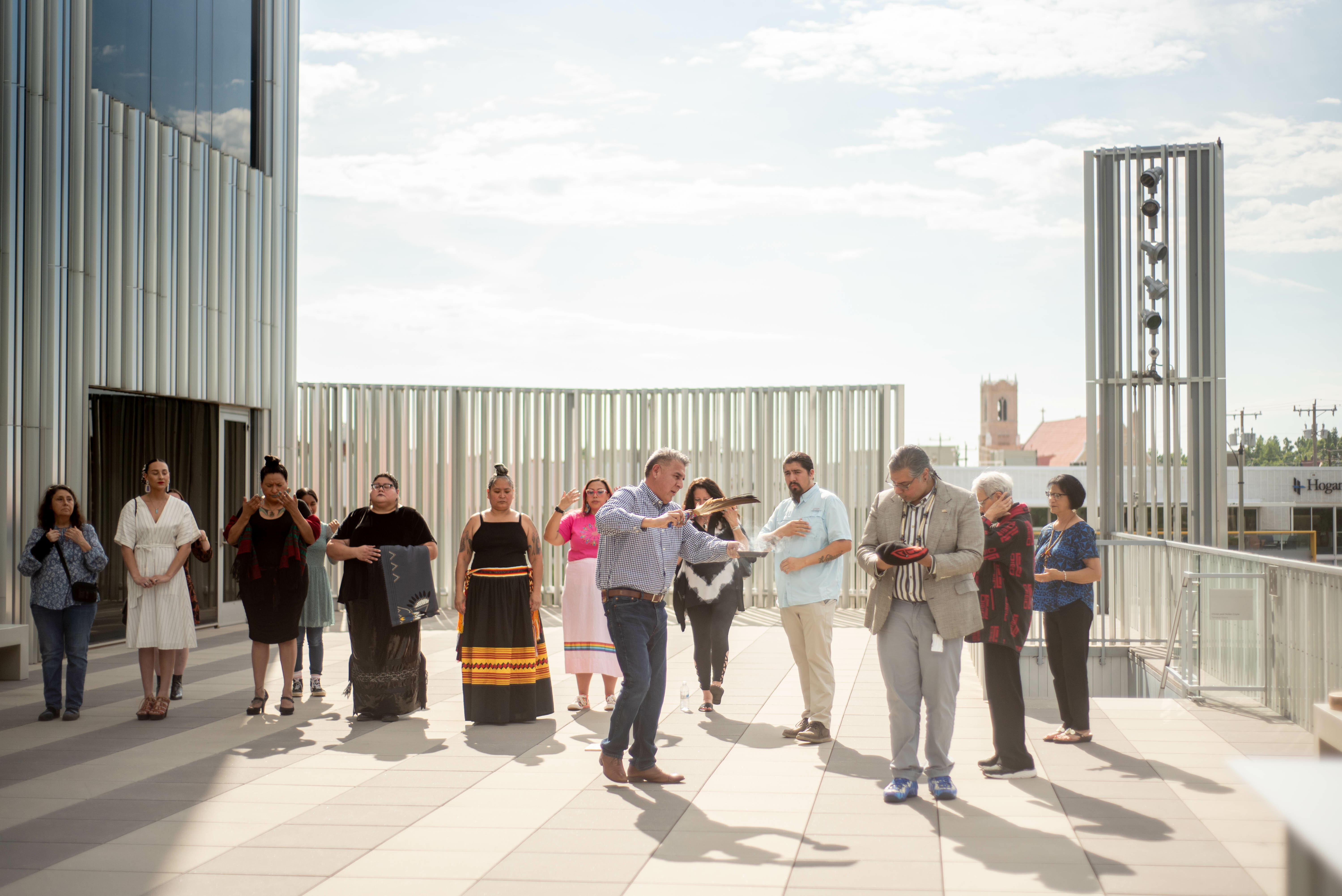
Smudging ceremony
“My heart was broken, but I read it for him,” Gentry says of Harjo's written statement. “I kept thinking, ‘who am I to speak for him?’ This made me look deep into myself and realize that it would be okay for me to; he spent his career encouraging and mentoring artists in a cultural manner so that I could do exactly that.”
"The biggest inspirations, however, come from growing up and developing a career around previous generations of artists who helped me pave the way, and the way many of us walk today," Harjo wrote. "I have always been encouraged by their talent and determination, and I pay my respects by following their advice and hoping that through their lessons, I may encourage and inspire those who come after me."
The impact and power behind Harjo’s words and works, Gentry’s paintbrush, Redcorn’s designs and Craig’s wallpaper are living testimonies of these very concepts Harjo referenced.
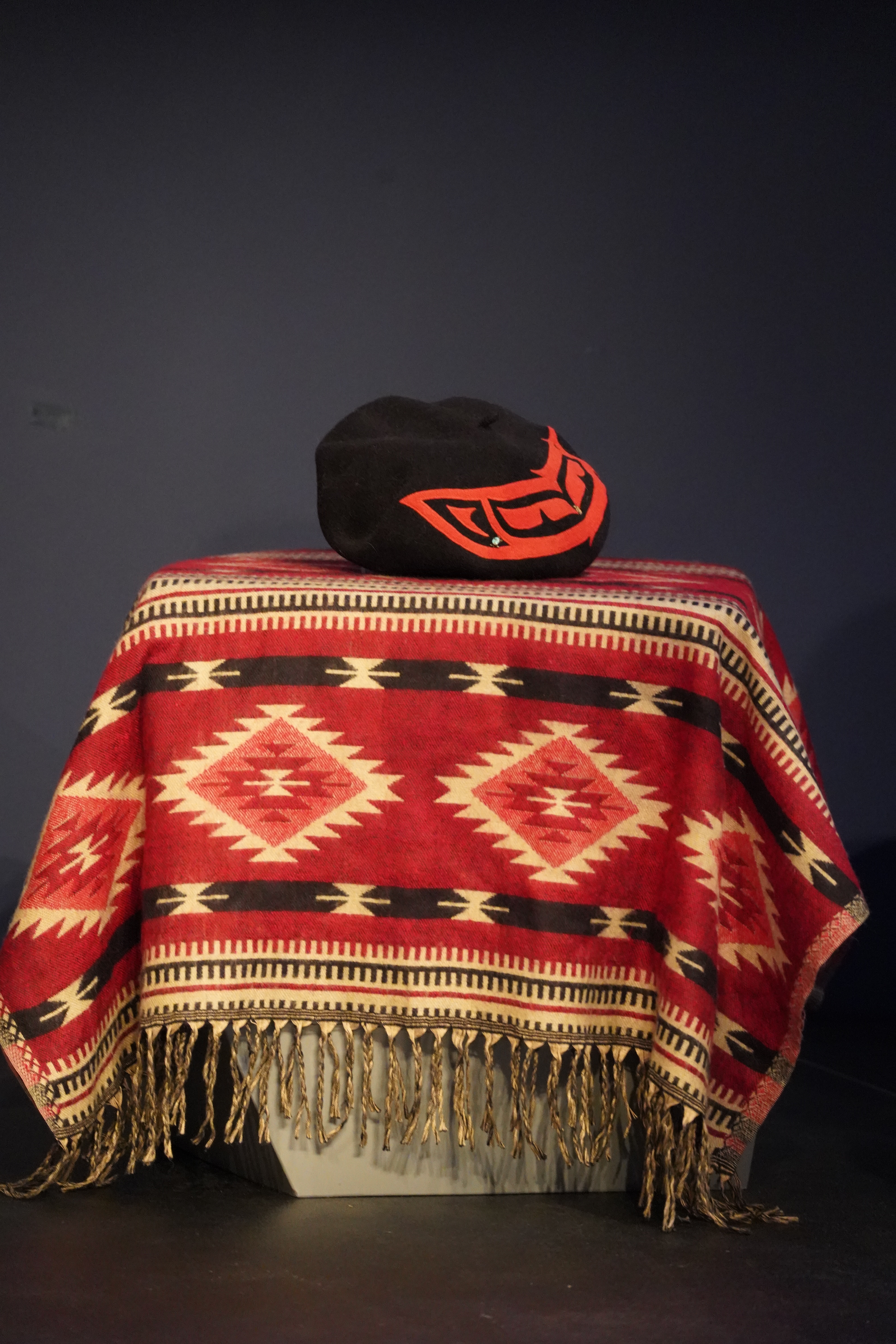
Harjo's signature beret
“Not many artists will have a chance to have their final artist statement known,” Gentry says. “Ben's impact on my life will never be forgotten, and I know I have to bring others up with me just like he did. That is how our culture is kept alive: by passing what we learn to the next generation. I think it's important that throughout the utmost devastating genocide attempts [of Indigenous peoples], artists have remained. The ancestors Ben and I have before us fought for survival, and we can keep them alive by using what we learn from them, our [vast] symbology and iconography.”
Patterns of Knowing is on view through Oct. 23. While loss ultimately brings grief, this exhibition shows how it is within these moments of sadness that something bright is already budding for the future, the work is already in progress and a sharing of knowledge has already begun.
As Barrera says, "Pampariyos ka tetakaxeiya, keakuh (Thank you, and until we meet again, friend)."
Images:
Installation view of Patterns of Knowing, including Benjamin Harjo Jr.'s Before the Tears (1995), Where Eagles Bear (1988), Four Phases (2007) and A Hare's Difference (2006). Photo: AJ Stegall.
Installation view of Jordan Ann Craig's Untitled (2019) and Sharp Tongue II (2022). Photo: Ann Sherman.
Installation view of Craig's Wallpaper I (2018), Ladybugs Are Birds (2019) and Wallpaper II: Eat Flowers for Powers (2023). Photo: Cassandra Watson.
Benjamin Harjo Jr. Photo courtesy of Tea Collection.
Artists Kristin Gentry (left) and Jeri Redcorn (right) in front of Redcorn's Ayo Wahdut Kuku Bit (Sky Earth Water II) (2023). Photo courtesy of the Caddo Nation.
In-progress view of Gentry working on Redcorn's Ayo Wahdut Kuku Bit (Sky Earth Water II) (2023). Photo: Jewell Shooting Star Gentry.
A group of Indigenous community members and artists gather for a smudging ceremony in Harjo's honor. Photo: Cody Giles.
Harjo's signature beret on stage during the opening artist talk. Photo: Kristin Gentry.
Return to New Light.
Monday 11 a.m. - 6 p.m.
Closed Tuesday
Wednesday 11 a.m. - 6 p.m.
Thursday 11 a.m. - 9 p.m.
Friday - Sunday
11 a.m. - 6 p.m.
see additional holidays
Visit us at
11 NW 11th St.
Oklahoma City, OK 73103
Phone: 405 951 0000
Fax: 405 951 0003
info@okcontemp.org
SEND MAIL TO
Oklahoma Contemporary
P.O. Box 3062
Oklahoma City, OK 73101
STAY UP TO DATE
Join our mailing list to learn about our events, exhibitions, education and more.
©2024 Oklahoma Contemporary All Rights Reserved.